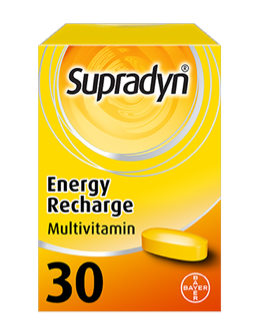FOR HEALTHCARE PROFESSIONALS
Symptoms and prevalence of vitamin and mineral deficiency
The usual symptoms of vitamin and mineral deficiency are unspecific and difficult to define and connect with a particular condition.
Fatigue and a general feeling of being “tired all the time” as well as impaired immunity are often early symptoms of micronutrient deficiency. Prolonged lack of optimal micronutrient status can lead to the development of chronic diseases, including osteoporosis, coronary heart disease, and cancer. Vitamin and mineral deficiency can also negatively affect those with already pre-existing medical conditions, further worsening their physical state. Nutritional status is a complex issue that is dependent on many circumstances related to lifestyle (e.g., level of physical activity, alcohol consumption, vegetarianism/ veganism), socioeconomic factors (e.g., poverty/low income, a hectic, stressful lifestyle, and so an inadequate time for shopping or cooking, an increased consumption of convenient, and often nutritionally-poor food), health (e.g., dieting, medication use), and geographical or mobility factors (e.g., no easy access to nutritious food, areas where food choice is dependent on season). In fact, many Europeans are not achieving the recommended daily intake of several key vitamins and minerals, including vitamin A, vitamin B12, calcium, zinc, magnesium, and many more . Although vital to normal functioning of a healthy organism, the minimum nutrient requirements are not met by many across different age groups. To maintain a healthy micronutrient status, supplementation with a combination of multivitamins and minerals is recommended.
Men and women do not achieve recommended daily intakes of certain micronutrients2
Effects of vitamin and mineral deficiency
- Even mild micronutrient deficiencies can result in shown symptoms2,3
- One of the primary reasons of people feeling low in energy is due to a dietary insufficiency in micronutrients. So, if you have low levels of micronutrients, that’ll quite often be seen as increased levels of fatigue and tiredness.
- A growing body of evidence is beginning to demonstrate the importance of optimum vitamin status for maintaining good health and preventing disease4-5
Short term: Suboptimal micronutrient status can lead to low energy, tiredness and impaired immunity 4,5
Long term: Suboptimal micronutrient status can impact the risk of chronic diseases (e.g. osteoporosis, coronary heart disease and cancer).5
REFERENCES
- Huskisson E, Maggini S, Ruf M. The role of vitamins and minerals in energy metabolism and well-being. J Int Med Res. 2007;35(3):277-289.
- Wishart K. Increased Micronutrient Requirements during Physiologically Demanding Situations: Review of the Current Evidence. Vitamins & Minerals. 2017;6(3):1-16.
- Dalal PK, Agarwal M. Postmenopausal syndrome. Indian J Psychiatry 2015;57(suppl 2):S222-32.
- Robinson SM. Improving nutrition to support healthy ageing: what are the opportunities for intervention? Proc Nutr Soc 2018;77(3):257–264.
- Elia M. The cost of malnutrition in England and potential cost savings from nutritional interventions (full report). Published on the British Association for Parenteral and Enteral Nutrition (www.bapen.org.uk) and National Institute for Health Research Southampton Biomedical Research Centre (www.uhs.nhs.uk/nihr-brc) websites. Print edition, November 2015.
REFERENCES
- Vallet GT. Embodied cognition of aging. Front Psychol 2015;6:463.
- Peters R. Ageing and the brain. Postgrad Med. J 2006;82(964):84-8
- Fjell AM, Walhovd KB. Structural brain changes in aging: courses, causes and cognitive consequences. Rev Neurosci 2010;21(3):187-221.
- Harada CN, et al. Normal cognitive aging. Clin Geriatr Med. 2013;29(4):737-52.
- Gille D. Overview of the physiological changes and optimal diet in the golden age generation over 50. Eur Rev Aging Phys Act 2010;7:27-36.
- Dalal PK, Agarwal M. Postmenopausal syndrome. Indian J Psychiatry 2015;57(suppl 2):S222-32.
- Gould DC, Petty R. The male menopause: does it exist? For: Some men need investigation and testosterone treatment. West J Med. 2000;173:76-8.
- Conley KE, et al. Oxidative capacity and ageing in human muscle. J Physiol 2000;526:203-10.
- Andriollo-Sanchez M, et al. Age-related oxidative stress and antioxidant parameters in middle-aged and older European subjects: the ZENITH study. Eur J Clin Nutr 2005;59(suppl 2):S58-62.
- Tan BL, et al. Antioxidant and oxidative stress: a mutual interplay in age-related diseases. Front Pharmacol 2018;9:1162.
- Poehlman ET, et al. Sodium-potassium pump activity contributes to the age-related decline in resting metabolic rate. J Clin Endocrinol Metab 1993;76:1054-7.
- Shimokata H, Kuzuya F. Aging, basal metabolic rate, and nutrition. Nihon Ronen Igakkai Zasshi 1993;30:572-6.
- Maggini S, et al. Immune function and micronutrient requirements change over the life course. Nutrients 2018;10(10):pii:E1531.






